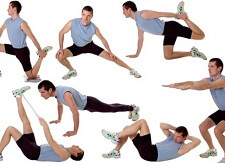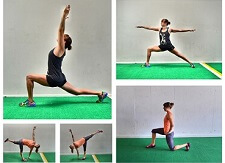- Home
- Knee Pain Treatment
- Home Remedies
Home Remedies For Knee Pain
Written By: Chloe Wilson, BSc(Hons) Physiotherapy
Reviewed by: KPE Medical Review Board
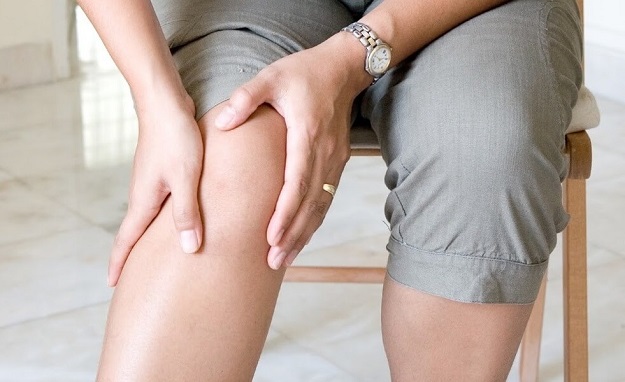
Home remedies for knee pain have always been popular but even more since the onset of coronavirus.
Many are worried about their knee pain and coronavirus has impacted the help and treatment they can access. Knee pain is a common problem affecting around 25% of adults.
We are being told how important it is to keep fit and healthy and to exercise regularly, but everything just got a whole load more complicated. So home remedies for knee pain are becoming increasingly important as we navigate the various restrictions that keep coming and going and as we navigate this new normal.
Best Home Remedies For Knee Pain
Here we will look at some of the best home remedies for knee pain. Maybe it’s a new episode of knee pain, maybe it’s an ongoing problem or maybe you would usually see a physical therapist or go to the gym to manage your pain. So what can we do to stay on top of knee pain at home?
#CommissionsEarned from Amazon on qualifying purchases
1. P.R.I.C.E.
One of the most well-known home remedies for knee pain, and the first line of treatment for knee injuries, is PRICE: protect, rest, ice, compression and elevation.
Ideally your doctor would want to see you face to face with a new incidence of knee pain and coronavirus is making this harder, so they may well start with a phone appointment and go from there right now.
- Protect: the joint from further injury. This will depend on the severity of the injury but may include wearing a knee brace or using crutches.
- Rest: take the pressure off the knee joint and allow it time to recover. Avoid activities that aggravate your knee pain and cut back on sports. It is important to get the right balance between resting and keeping active which will depend on the type, severity and timing of the knee injury.
Trying to do too much too soon could delay healing and cause further knee damage, but resting too much or for too long can lead to muscle weakness and tightness. LEARN MORE > - Ice: regularly applying ice is one of the oldest home remedies for knee pain and is particularly useful immediately after a knee injury. Applying ice regularly in the first few days after a knee injury not only helps to reduce knee pain, but it also reduces the amount of swelling in the knee and can help speed up healing.
Ideally, an ice pack should be applied for 10-15 minutes every couple of hours. You might not have a fancy ice pack for your knee pain and coronavirus might be stopping you from leaving the house, but there are lots of different ways to apply ice. LEARN MORE > - Compression: Compression bandages such as tubigrip help to reduce knee swelling and support the joint. LEARN MORE >
- Elevation: If there is any swelling in your knee, however minor, it will aggravate your knee. When resting, try and have the leg elevated so that your foot is higher than your heart. This is easiest to do when lying down in bed or on the sofa by propping your legs up on cushions or pillows or a specially designed leg elevation cushion.
If the knee pain is fairly mild with only a small amount of swelling, try self-managing at home with PRICE. If things don’t improve after a week of using home remedies for knee pain, contact your doctor.
2. Knee Exercises
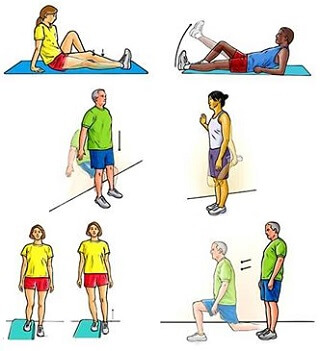
One of the most effective home remedies for knee pain is exercises. By working on the strength, flexibility and stability of the knee, many causes of chronic knee pain will start to improve.
People often feel they need to go to the gym or use fancy equipment, but actually, there are loads of great knee exercises you can do at home.
Having good strength in the buttocks, thighs and calves helps to support the knee and reduce the forces going through the joint. Pain inhibits muscle function so if you are suffering from knee pain, there is a high chance that your muscles aren’t working as well as they were so they need extra attention.
As a physiotherapist, I saw countless times how working on a simple home exercise knee strengthening programme made massive improvements to people’s knee function, pain levels and quality of life. Simple piece of equipment such as resistance bands can help make exercises more interesting and challenging.
Exercises are still just as important right now for knee pain and coronavirus does not, in most cases, change that. If anything, it makes them one of the most important home remedies for knee pain. LEARN MORE >
3. Stretches
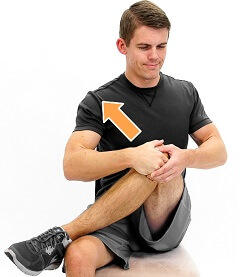
We all know that having good flexibility in our muscles reduces the risk of knee injuries, but it also reduces the forces going through our joints.
One of the first things muscles do if you are experiencing knee pain or have an injury is to try and protect the knee joint, often tightening to make the muscles act like a knee brace. Now this is great in the initially phase after a knee injury, but after a few days, it actually starts to impede healing. Muscle tightness limits knee movement, changes how the forces travel through the leg and can limit function.
So once a knee injury has settled down, and you have started to build up the strength in your knee, then knee stretches become a really important part of rehab. It can be really easy to focus on the initial part of rehab following an injury and this is particularly true now we are dealing with the daily impact and changes from coronavirus, but unless we see rehab through, including stretching out tight muscles, then knee pain is likely to return. LEARN MORE >
4. Work Out What Is Wrong
Treatment for knee pain will depend on what is wrong. The best way to get an accurate knee pain diagnosis is to see your doctor, but where does that leave people dealing with knee pain and coronavirus restrictions? They still need to know what home remedies for knee pain are right for them.
Knee pain should be evaluated by your doctor if there is:
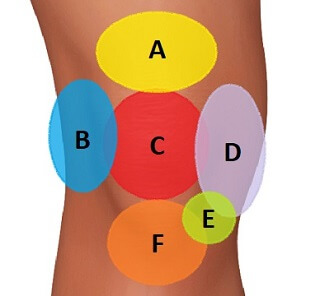
- Moderate to severe knee swelling and/or pain
- A deep cut
- Knee locking - where the knee gets stuck in one position and you can’t move it
- The knee keeps giving way or you are unable to bear weight on it
- Your sleep is affected
- Your knee pain is getting progressively worse
- Daily activities are affected
We have developed a handy knee pain diagnosis chart to help your work out what is wrong with your knee so you can choose the best home remedies for knee pain for you. It looks at where your pain is and what other symptoms you have to help you work out what is wrong. LEARN MORE >
5. Medication
Primary care doctors and GP’s are typically the first port of call for medications for knee pain and coronavirus hasn't changed that. Yes, it might be harder to see a doctor face to face but in many countries they will be able to provide advice over the telephone or email and send required prescriptions electronically to pharmacies. Those pharmacies may be able to deliver, you may be able to collect them in person or ask someone else to collect them for you and deliver.
6. Natural Pain Relief
Heat is one of the best natural home remedies for knee pain relief. Placing a heat pack or hot water bottle over the knee helps to increase blood flow to the knee joint. This brings in fresh oxygen and nutrients to aid healing, helps to relax muscles and helps to reduce knee pain.
It is important to use heat safely e.g. only applying a heat pack for 10-20 minutes at a time, but heat is an effective and one of the simplest home remedies for knee pain.
Heat works best with chronic knee problems or where there has been knee pain for at least a couple of weeks. Heat should not be used on acute injuries or else it may make things worse, other home remedies for knee pain such as ice and rest are more appropriate initially.
Other options for natural pain relief include anti-inflammatory gels that you can rub in to the affected area so you get the benefit of anti-inflammatory medication without the side effects.
A TENS machine is another great options for home remedies for knee pain. These small, compact devices have adhesive pads that you position around the painful area that deliver small electric impulses that block pain signals. They are an extremely effective way of reducing pain. Find Out More >
7. Supplements
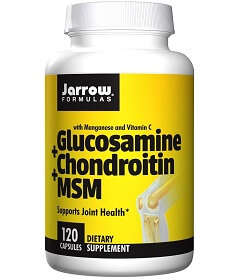
Homeopathy and supplements are becoming increasingly popular home remedies for knee pain and many can be bought safely online from places such as Amazon.
Glucosamine, chondroitin and omega-3 are amongst the most popular for people with knee arthritis but there are other things like cherries, dandelion leaves and celery can also help. LEARN MORE >
8. Keep Moving
It can be very tempting to stop moving around if you have knee pain, but in many cases, movement actually helps. If you have recently injured your knee, yes it is really important to rest and avoid aggravating activities, but stopping completely actually makes things worse. LEARN MORE >
For people with long term knee pain, or conditions such as knee arthritis, keeping the knee moving is extra important. When the knee moves, blood and fluid are pumped through the joint bringing with them fresh oxygen and nutrients and carrying away inflammatory chemicals and excess fluid, which all help to reduce knee pain and swelling.
A good guide is to try to:
- Limit Sitting: to 20-30 minutes after which either get up and walk around for a few minutes,
- Go Up And Down The Stairs: a few times
- Do Some Knee Exercises: either sitting down or standing up
Not only will it help reduce knee pain, regular movement also helps reduce knee stiffness and keeps the knee strong and flexible. It is also good for your other joints and muscles too.
9. Weight Loss & Diet
Being overweight place extra force through the knee joint and puts you at extra risk of developing knee pain and conditions such as knee arthritis. Obesity also leads to inflammation in joints also resulting in pain.
It may feel daunting to think about trying to lose weight with knee pain but there are lots of things you can do at home.
A healthy diet is a balanced one that is high in fruit, vegetables and fibre, and low in meat and fats. There is brilliant advice on this on the NHS UK website "Eating A Balanced Diet". It also has a BMI calculator to help you check whether you are a healthy weight.
They even have the 12-week “NHS Weight Loss Plan” to help you lose weight safely and effectively if your BMI is 25 or over. It has been downloaded over 7 million times and not only helps you lose weight, but helps you to keep the weight off.
10. Get Your Heart Rate Up
Not only does cardiovascular exercise keep your body strong, it helps with achieving and maintaining a healthy weight. If the current coronavirus restrictions in your county allows, get out each day for a brisk walk, run or bike ride. Aim for 30 minutes of cardiovascular exercise – this may be too much to start with but start with what you can and gradually build up by 10% each week either in distance or speed.
If you can’t leave the house, try activities such as:
- Skipping – you may need to get creative for a skipping rope e.g. a dressing gown belt or length of rope
- Running on the spot or around a room
- Going up and down stairs
- Exercise DVD
If you have access to the internet there are loads of cardio workout programmes on YouTube, both live streamed and archived. There are loads to choose from but the important thing is to find one that is right for you. One of my favourites is:

11. Posture
A lot of posture advice focuses on the lower back, which is really important, but there are also things you can be aware of to help reduce knee pain. It can be very tempting to spend a lot of the day sitting if you have knee pain so good knee posture is doubly important.
If you have knee pain when you are sitting down or first get up, or your knees are at all swollen, then anytime you do sit, make sure your legs are raised up. Rest them on a high footstool or a chair, and make sure the back of the knee is supported with pillows – if only the feet are supported, then the back of the knee is left hanging which can make the knee really sore when you then try and get up.
Also try and ensure the knee is as straight as possible as resting with the knee bent can lead to muscle tightening and joint stiffness.
12. Self-Massage
Some people find massage with essential oils helps to reduce knee pain and coronavirus restrictions have limited access to massage therapists, so now is the perfect time to learn how to self-massage.
Massage has been used for centuries as part of home remedies for knee pain to help relax muscles, stretch, reduce swelling and improve general well-being. There are loads of great videos on YouTube that show you how to do self-massage for knee pain – one of my favorites is:

Does Coronavirus Cause Knee Pain?
Coronavirus can indeed cause joint pain, but if knee pain is your only symptom, it is unlikely to be related to coronavirus. Remember, the main symptoms of COVID-19 are a raised temperature and a persistent cough.
What Else Can Help?
I hope this article has given you confidence that you can manage your knee pain at home. Keep active as much as you can, look after yourself, stay safe and try these home remedies for knee pain to see which ones work best for you.
You might also be interested in the following articles:
- Front Knee Pain
- Inner Knee Pain
- Knee Pain Diagnosis Chart
- Swelling Behind The Knee
- How To Do Stairs With Knee Pain
Page Last Updated: 01/02/24
Next Review Due: 01/02/26
